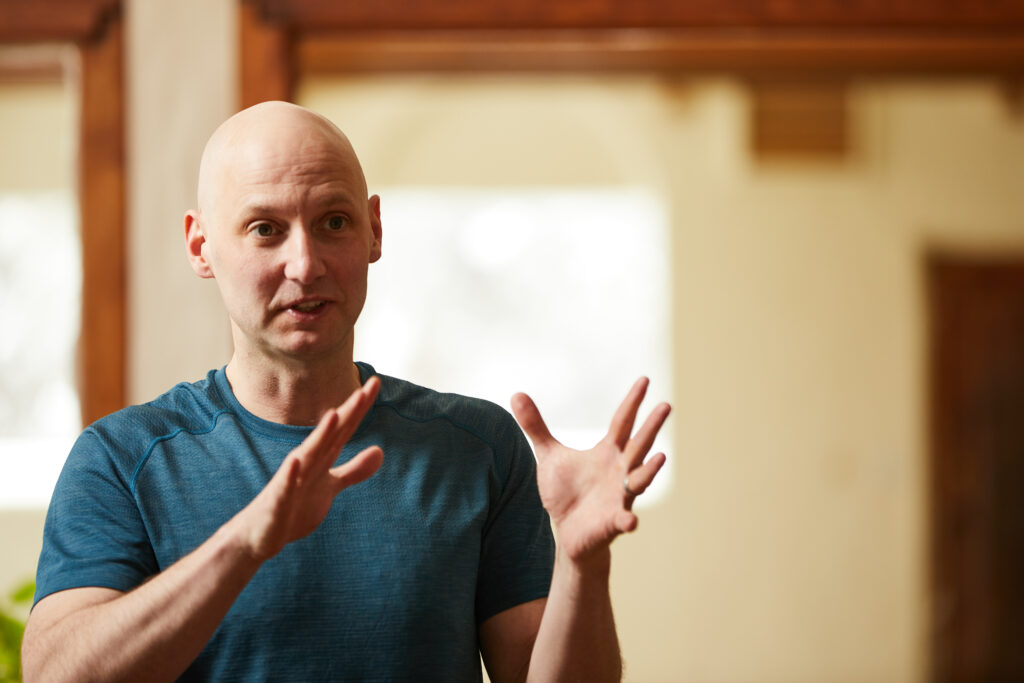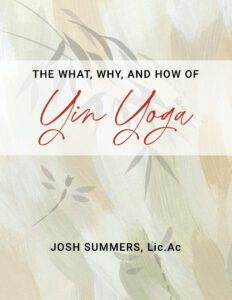In order to understand what Yin Yoga is really about, it helps to directly address what it’s not about. Clear and safe instructions on how to practice Yin Yoga are critically important, so here’s some straight talk about some of the most common myths and biggest misconceptions out there.
Myth 1: Yin Yoga is about dimming the lights, lying over a bolster, and blissing out.
Yin Yoga might look like a stylized version of restorative yoga, but the internal experience is quite different. We might strategically use props in Yin, but in this practice props aren’t meant to eliminate discomfort. Instead, we use them to actually bring an appropriate degree of stress to our body – either by increasing or decreasing sensation – so that our tissues benefit from the exercise. While we let our bodies steep at the edge of mild and moderate stress, sensations can become slightly bitter and achy, and our chattering minds often proliferate a lot of unbidden thoughts. That’s when the magic of Yin Yoga happens: By acknowledging and softening around these experiences, we’re able to reset our default mode of being, so that rather than reacting to our feelings, we can cultivate an internal awareness and spaciousness to engage with our inner worlds from a place greater freedom and understanding.

Myth 2: Yin Yoga overstretches ligaments and destabilizes joints.
When people hear about the idea of stressing joints, their hackles go up. They worry about overstretching dense connective tissues and ligaments. I’ve noticed that this fear often comes from confusing “stress” with “stretch.” Stress is force applied to something, in this case our joint tissue. Stretch is the subsequent lengthening that occurs due to the stress placed on that tissue. But not all stress causes stretch. And in Yin Yoga, the intention is to safely and moderately stress our joints to promote the health of the tissues in and around our joints – not to overly lengthen these tissues. In Yin Yoga, great care is given to observing the kinds of sensations one experiences, emphasizing the mild end of the sensation spectrum – not pushing, pulling, or striving to go deeper, and always avoiding any signal of pain. Practiced intelligently, Yin Yoga is a tissue-specific exercise, and shouldn’t be approached with the mindset of “more is better.” Of course, as with any yoga style, people might override the alarm signals of pain and end up injured. Intention and awareness are key to safe practice, no matter the style.
Myth 3: Yin Yoga encourages “dumping” into joints.
All yoga applies various forces to our bodies. Those forces are described as tensile forces, compressive forces, and sheering forces. I’ve found that people tend to think of “compression” (compressive forces) as flat-out bad. Yoga teachers of many styles might even say, “Don’t compress your lower back” or “don’t hang in your lower back” or “don’t dump into your joint.” But to maintain their health, all tissues require stress. Without stress or exercise, tissues atrophy. Yin Yoga encourages a positive stress on tissue, which is sometimes compressive. For example, in passive Yin Yoga backbends we exercise our spines by gently compressing the lumbar vertebrae.
Myth 4: Yin Yoga doesn’t care about alignment.
Yin Yoga teachers don’t shower students with absolute rules of precise alignment, so people might think that alignment doesn’t matter to Yin practice. But in Yin Yoga, alignment absolutely matters – there’s just no one absolute alignment that works for everyone. Yin Yoga acknowledges the fact that everyone’s body is unique, especially on the skeletal level. Because of skeletal variations (differences in shapes, lengths, orientations, angles, and curvatures of bones) – between bodies and within bodies – Yin Yoga encourages students to modify poses to suit their bodies, explore their experiences, and find an alignment that situates them with the intention of each posture. Modifications aren’t the exception; they’re the norm.
Myth 5: Yin Yoga is for lazy people.
People often think that being into Yin Yoga means you’re “too lazy” to do a flow class or that you’re fooling yourself that it’s “exercise.” First, it’s not a standalone, complete practice unto itself; Yin Yoga a supplemental practice to active forms of exercise. No one should practice only Yin Yoga as their form of exercise. Many Ashtangis love to do Yin in the evening before bed to balance their active practice. They also have more grace in the Mysore room thanks to it. Cross-Fitters even have their own version of Yin Yoga called ROM-WOD (Range of Motion Workout of the Day), and they find that their bodies recover faster and are less inflamed because of incorporating the principles of Yin Yoga. Avid runners love Yin Yoga for similar reasons.
Myth 6: You need to be “all-zen” to practice Yin Yoga.
Because Yin Yoga tends to be quiet and still, students think they have to already be quiet and still to practice. Not true. If anything, Yin Yoga is a practice within which we can explore a new relationship toward our scattered, restless selves. Through the gentle act of intending to be present, intending to be mindful, and intending to be compassionate, we can start softening the fidgety patterns of the mind and gradually cultivate habits of calm and stillness. Developing this as a skill can help us in our hectic, everyday lives.
Myth 7: You shouldn’t practice Yin Yoga if you’re pregnant.
During pregnancy, the hormone relaxin is produced, relaxing ligaments to prepare the birth canal for delivery. In turn, pregnant women often think that doing Yin Yoga during pregnancy will overstretch their ligaments. But this concern could apply to all types of yoga during pregnancy. In Yin Yoga, we cue mothers-to-be not to go past their normal ranges of motion, to not try to increase their ranges of motion. Like any yoga practice, Yin Yoga offers various modifications to accommodate a growing baby. For example: No deep twisting or compression on the abdomen. All told, many expectant mothers find that the gentle stimulation of Yin releases aches and tensions, and smooths their energy flow.
—
Hope this helps as a summary. In the next segment, I’d like to do a deeper dive into Myth #4 and talk about the concept of Functional Alignment.
Practice Opportunities:

